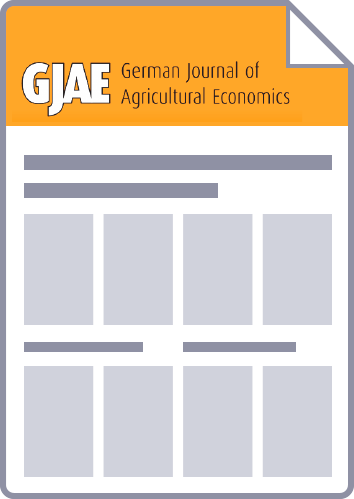Some Reflections on Income and Environmental Effects of Agri-Environmental Programmes under EU Directive No. 2078/92The present article discusses effects of the agri-environmental programmes implemented under EU directive No. 2078/92. These programmes are aimed above all to bring about environmental improvements but also to reduce production surpluses and to maintain agricultural incomes. However, on the basis of directive No. 746/96 the net income effect (the "incentive element") must not exceed 20 % of the income losses to be compensated; otherwise these payments would not be compatible with the GATT agreement.A theory-based analysis of accessible information on the application of the agri-environmental programmes including the results of the authors' interviews with farm managers, reveals that in the German Länder these programmes generate high income effects that partly go far beyond the 20 % limit. The major reason is that premia are not - or not sufficiently - differentiated according to the farm's cost of participating in the respective measures. The share of farms that merely continue the practices subsidized under the programmes, tends to be considerable, and often the premia granted to them are not even reduced. Furthermore, the premia paid to those farms that introduce the relevant practices are most often not differentiated. In addition, high net income effects occur for those farms that change farming practices for other reasons than the premia offered. "Horizontal" programme elements, offered indiscriminately to all regions, and often endowed with a uniform premium, are much more important than programmes targeted to specific regions. It is shown that various programme items are characterized by a very high degree of participation of farms that hardly change farming practices and a low participation of farms with major - and costly - adaptation requirements. This results in a relatively high income efficiency and a low environmental efficiency of premia.Against the background of the preceding theoretical and empirical analysis various arguments brought forward to justify the present premia system are discussed: The necessity of (1) ensuring the continuation of farming practices otherwise jeopardized, (2) creating a sufficient financial incentive, (3) avoiding the high transaction costs involved in a differentiation of premia, (4) non-discrimination of "early environmental pioneers". Even if these arguments hold in part, they do not invalidate the statement that the present system (a) shows high income and low environmental effects and (b) implies distortions in competition in international trade of agricultural products. As long as there are no feasible, outcome-oriented concepts of remunerating positive externalities of agricultural production, premia must be oriented at losses of income - unless the high level of transaction costs and/or the low environmental effects make it seem advisable to refrain from implementing the respective programme items.Finally, an attempt is made to help explain the present income bias of the agri-environmental programmes using concepts of New Political Economy. This involves a discussion of (a) the importance for decision makers of transaction costs and unwarranted side-effects of a more objective-oriented shaping of programmes, (b) the possibility of collusion by the agent (government of the Land) with the agricultural profession, (c) the question of the possible participation of the principal (EU) in such collusion, and (d) the causes and consequences of the unusual evaluation procedure. In this context the EU's deficit in democracy in the field of agricultural policy is referred to.
HEINZ AHRENS, CHRISTIAN LIPPERT, MICHAEL RITTERSHOFER
Published: 01.02.2000 〉 Heft 2/2000 〉 Resort: Articles
Submitted: N. A. 〉 Feedback to authors after first review: N. A. 〉 Accepted: N. A.
DOI:
N. A.
ABSTRACT
CONTACT AUTHOR

DOWNLOAD THIS ARTICLE HERE
RELATED ARTICLES
Ermittlung der Nachfrage nach ökologischen Gütern der Landwirtschaft – Das Northeim-Projekt
The demand for ecological goods in decentralised agri-environmental payment schemes
Published: 05.12.2003
Authors: Anke Fischer, Sonja K. Hespelt, Rainer Marggraf
This paper presents a case study on the development and implementation of a decentralised and outcome-based agri-environmental payment scheme in a project region in central Germany. A research group from Goettingen University together with local actors designed the scheme which complies with the European Union’s Common Agricultural Policy. The core of the programme is the…
Evaluierung von Agrarumweltprogrammen auf Grundlage der Umwelteffizienz landwirtschaftlicher Betriebe
Published: 08.04.2008
Authors: Tammo Francksen, Uwe Latacz-Lohmann
This paper sets out to develop an economic framework for ex post evaluations of agri-environmental schemes. We begin by developing a non-parametric model for estimating farm-level environmental efficiency scores. We then use this efficiency framework to devise a set of economic criteria for evaluating agri-environmental schemes. One key criterion is whether an environmental scheme has…
Überlegungen zu Umwelt- und Einkommenswirkungen von Agrarumweltprogrammen nach VO (EWG) Nr. 2078/92 in der Landwirtschaft
Published: 01.02.2000
Authors: HEINZ AHRENS, CHRISTIAN LIPPERT, MICHAEL RITTERSHOFER
Some Reflections on Income and Environmental Effects of Agri-Environmental Programmes under EU Directive No. 2078/92 The present article discusses effects of the agri-environmental programmes implemented under EU directive No. 2078/92. These programmes are aimed above all to bring about environmental improvements but also to reduce production surpluses and to maintain agricultural incomes. However, on the…


